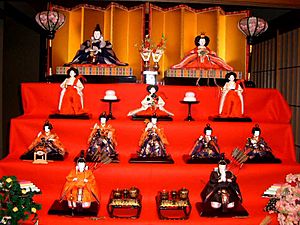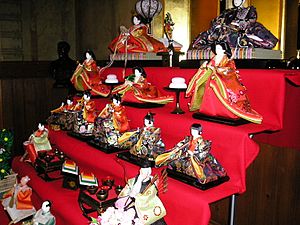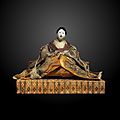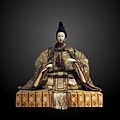Hinamatsuri facts for kids
Hinamatsuri (雛祭り (Hina-matsuri)), also called Doll's Day or Girls' Day, is a special festival in Japan. It is celebrated every year on March 3. This day is all about wishing young girls in Japanese families good health and happiness.
Contents
The Story Behind Hinamatsuri
For a very long time, since the 700s, Japan has had special days for children. March 3 was for girls, and May 5 was for boys. This tradition has continued for many centuries.
The Special Doll Display
The most important part of Hinamatsuri is a beautiful display of dolls. These dolls are dressed in the fancy clothes of the Heian period, which was a long time ago in Japanese history. The group of dolls represents the old Japanese Imperial court, like a royal family and their helpers. These special dolls are called hina ningyō.
The dolls are placed on steps, which are called hina dan (error: {{nihongo}}: Japanese or romaji text required (help)). These displays usually have five or seven steps. The way the dolls are placed can be a little different depending on the region in Japan, like the Kantō region or Kansai region. However, the types of dolls on each step are always the same.
First Step: The Emperor and Empress
The very top step holds two special dolls. These are the imperial dolls, called dairi-bina (error: {{nihongo}}: Japanese or romaji text required (help)).
- The male doll is the Emperor (御内裏様 (Odairi-sama)). He holds a special stick called a shaku (笏 (ritual baton)).
- The female doll is the Empress (御雛様 (Ohime-sama)). She holds a fan.
Sometimes the male doll is on the right, and sometimes he is on the left.
Second Step: The Court Ladies
The second step holds three court ladies (三人官女 (san-nin kanjo)). Each of these ladies holds something used for serving sake, which is a Japanese drink.
Third Step: The Musicians
The third step has five male musicians (五人囃子 (gonin bayashi)). They are ready to play music for the court.
Fourth Step: The Ministers
On the fourth step, you might see two Imperial ministers, who were important officials.
- One is the Minister of the Right (右大臣 (Udaijin)).
- The other is the Minister of the Left (左大臣 (Sadaijin)).
Related pages
Images for kids
-
A Hinamatsuri store display in Seattle, Washington, showing all seven steps.
See also
 In Spanish: Hinamatsuri para niños
In Spanish: Hinamatsuri para niños









